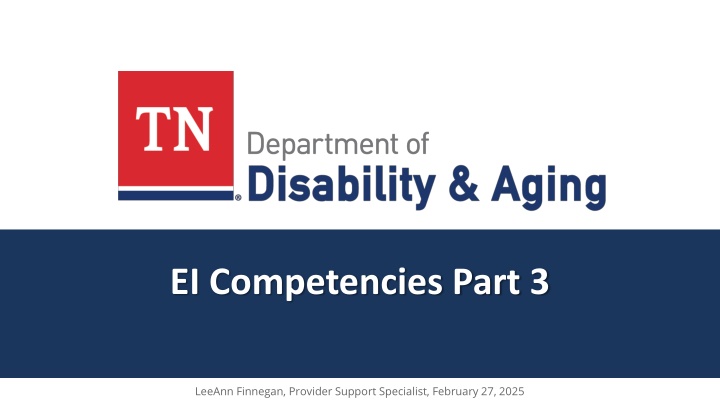
Effective Implementation Strategies for Child Intervention Support
Explore the essential competencies and components for effective Early Interventionists (EIs) in supporting children and families. Learn about coaching, collaboration with caregivers, and promoting child development through evidence-based practices.
Download Presentation

Please find below an Image/Link to download the presentation.
The content on the website is provided AS IS for your information and personal use only. It may not be sold, licensed, or shared on other websites without obtaining consent from the author. If you encounter any issues during the download, it is possible that the publisher has removed the file from their server.
You are allowed to download the files provided on this website for personal or commercial use, subject to the condition that they are used lawfully. All files are the property of their respective owners.
The content on the website is provided AS IS for your information and personal use only. It may not be sold, licensed, or shared on other websites without obtaining consent from the author.
E N D
Presentation Transcript
EI Competencies Part 3 LeeAnn Finnegan, Provider Support Specialist, February 27, 2025
Check-In FGRBI Application Competencies 6-10 Questions/Wrap Up Agenda
EI Application Competencies
EI Competencies Two segments: Knowledge Competencies Application Competencies Adults learn through the 3 A s: 1. Acquiring knowledge 2. Assimilating knowledge 3. Applying knowledge
Application Competency 6 Effective EIs should be able to: Identify and coach others (caregivers and team members) to apply evidence informed and contextually matched interventions for the child and family.
Components of Application Competency 6 Collaborate with caregivers to arrange, modify, and adapt the child s environments to promote child s access to and participation in learning experiences in activities and routines. Identify and discuss with caregiver options of interaction, communication and instructional strategies that promote child engagement and learning across developmental domains (e.g., cognition, motor, social communication, problem solving, and social emotional) with family and peers.
Components of Application Competency 6 Describe, demonstrate, and support: Caregiver use of interactional strategies with fidelity that encourages responsive interactions and reciprocity including: observing, joining in and expanding on the child s focus, modeling, responding contingently, interpreting intentions, and providing natural consequences. Caregiver use of communication strategies with fidelity that encourage verbal and nonverbal understanding and production by using gestures and language to label and expand on the child s requests, needs, preferences, or interests, modeling and scaffolding gestures, vocalizations, words and combinations, and by responding contingently, interpreting, providing natural consequences.
Components of Application Competency 6 Describe, demonstrate, and support: Caregiver use of instructional strategies with fidelity that encourages participation and independence including: modeling, responding contingently, providing natural consequences, using wait time and prompting. Caregiver ability to promote the child s exploration of the environment, self-directed learning, self-regulation, and problem- solving behavior by observing, interpreting, and scaffolding in routines, activities and play.
Components of Application Competency 6 Apply knowledge of current research and evidenced based practices to provide and demonstrate alternative intervention strategies for caregiver to choose and apply. Collaborate with caregivers on the introduction and use of Augmentative Alternative Communication (AAC). Coach caregivers to use explicit feedback and consequences to increase child engagement, play, and skills and to maintain appropriate levels of support for learning to continue.
Components of Application Competency 6 Use functional assessment and related prevention, promotion, and intervention strategies across environments to prevent and address challenging behavior. Adapt specific instructional strategies that are effective for dual language learners when teaching English to children with disabilities.
Application Competency 7 Effective EIs should be able to: Engage in coaching matched to caregiver support needs.
Components of Application Competency 7 Use a systematic coaching framework with adults that includes practice with repetition and reflection to support their learning. Describe and provide concrete examples to caregivers about the key components of an evidence and practice- based coaching framework. Observe caregiver s implementation of intervention strategies and provides supportive and constructive feedback.
Components of Application Competency 7 Use a variety of coaching strategies (direct teaching, demonstration with narration, guided practice, caregiver practice, problem solving and reflection) with fidelity to support caregiver learning and independent practice. Apply knowledge of current research and evidence-based practices to provide and demonstrate alternative intervention strategies for caregiver to choose and apply. Coach caregiver to use identified intervention strategies with fidelity within routines and play.
Components of Application Competency 7 Provide multiple opportunities within each session for the caregiver to reflect on practice, interpret impact and critically evaluate use. Problem solve with caregiver on what works and how targets, strategies and embedding could be expanded or revised to improve outcomes.
Components of Application Competency 7 Support caregiver to plan intervention that will occur between sessions. Encourage caregiver autonomy through information sharing, practice, reflection, problem solving, and review.
Application Competency 8 Effective EIs should be able to: Facilitate coordinated and collaborative teaming practices.
Components of Application Competency 8 Work with providers from multiple disciplines and the family as a team to support family participation, to plan and implement supports and services that meet the unique needs of each child and family, and to ensure the role of the family as decision maker. Encourage providers and families to work together as a team to systematically and regularly exchange expertise, knowledge, and information to build team capacity and jointly solve problems, plan, and implement interventions in a coordinated and collaborative manner.
Components of Application Competency 8 Use communication and group facilitation strategies to enhance team functioning and interpersonal relationships with and among team members. Collaborate with team members to discover and access community-based services and other informal and formal resources to meet family-identified child or family needs. Collaborate with family and team members to identify one practitioner from the team who serves as the primary liaison between the family and other team members based on child and family priorities and needs if a primary provider model is appropriate.
Components of Application Competency 8 Coordinate consultation as needed to ensure family and child have access to all team members when appropriate or important for information and decision making. Support use of systematic communication and documentation procedures including use of technology to support team meetings for each child and family.
Application Competency 9 Effective EIs should be able to: Use technology to support child, family and team members to communicate and participate.
Components of Application Competency 9 Support caregiver s participation in team meetings with other professionals using technology. Integrate the use of technology to support video reflection and modeling with caregivers and extended family participants. Participate in and shares online resources with caregivers to support learning for the child and family.
Components of Application Competency 9 Use technology such as video conferencing or telepractice to support caregiver and child opportunities for assessment, intervention and peer interaction. Work with families and other adults to identify each child s and/or family needs for assistive technology to promote access to and participation in learning experiences.
Application Competency 10 Effective EIs should be able to: Support family and team-based assessment and progress monitoring.
Components of Application Competency 10 Share information about typical and atypical child development across developmental domains, learning differences and disability as appropriate for the family to make decisions regarding assessment and intervention planning. Include family in decisions about gathering assessment information including family information and the process to be used by the team. Use assessment materials and strategies that are appropriate for the child s age, development, and accommodate the child s sensory, physical, communication, cultural, linguistic, social, and emotional characteristics.
Components of Application Competency 10 Use a variety of methods, including observation and interviews, to gather assessment information from multiple sources, including the child s family and other significant individuals in the child s life. Obtain information about the child s participation and skills in daily activities, routines, and environments such as home, center, and community. Collaborate with family to gather and use data to inform decisions about outcome development and intervention.
Components of Application Competency 10 Implement systematic ongoing assessment to gather information to share with the family on learning targets, to plan activities, to monitor the child s progress and to revise instruction as needed. Use assessment tools, including observation and family report, with sufficient sensitivity to detect child progress, especially for the child with significant support needs.
Components of Application Competency 10 Use the 5Q or family preferred visual model format so that family has the ability to know when it is working in their intervention throughout the day. Collaborate with family and team to develop data based, individualized transition plan using ongoing assessment information and family input.
References FGRBI Early Intervention (EI) Competencies: http://box5495.temp.domains/~fgrbicom/wp- content/uploads/2020/03/EICompetencies.pdf
Upcoming Meetings February 28, 2025, at 11:30 Central/12:30 Eastern: EI Q&A March 7, 2025, at 1:00 Central/2:00 Eastern: Monthly Directors Teaming Meeting Center Based Directors: Center focused discussion prior to all directors meeting at 12:30 Central/1:30 Eastern. March 26, 2025, at 11:30 Central/12:30 Eastern: Lunch and Learn
Upcoming Meetings Coffee Breaks March 27, 2025, at 11:30 Central/12:30 Eastern: Media Literacy and Identifying What is an Evidence-Based Practice? April 24, 2025, at 11:30 Central/12:30 Eastern: Evidence Based Practice-Accessing, Interpreting, and Applying to EI Practice
Contact Information LeeAnn Finnegan Provider Support Specialist LeeAnn.Finnegan@tn.gov 629-259-3711






















